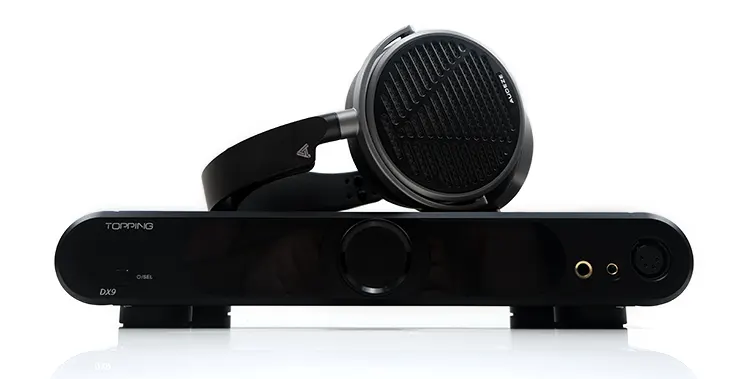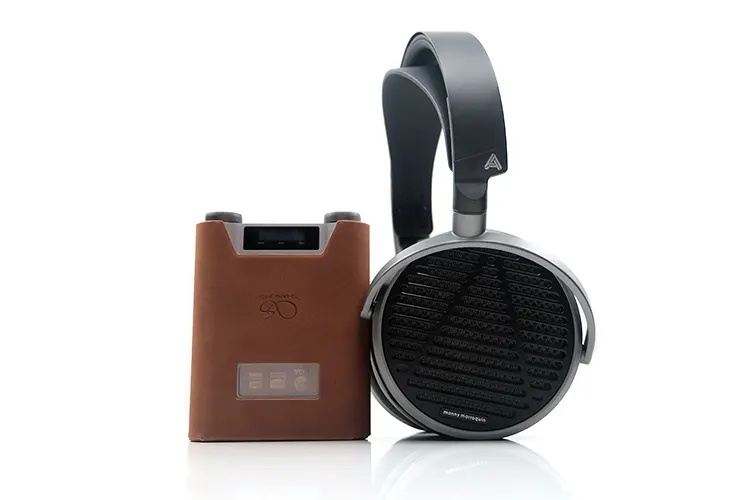Sound Impressions
The following sound impressions of the Audeze MM-100 were created using a mix of the Rupert Neve RNHP analog amplifier, a Topping DX9 integrated DAC/amp, and the Shanling H5.
Summary
The MM-100 offers pleasing some continuity with what I would describe as the new ‘Audeze’ tuning. Something I first experienced with the LCD-5 and the MM-500.
At a high level, this is typified by a neutrally colored, energetic sound signature characterized by a linear but punchy bass response, a forward midrange with strong vocal performances, and a set of highs that tends to stay close to the Harman Target either slightly above or below.
However, the trickle-down in this tuning for each successive headphone is by no means a duplication of what came before, at least to my ears.
In the case of the MM-100, it’s more about the treble response and a noticeable drop in the 4-6k range. That can take the sting out of brighter percussion mixes by masking some of the overtones from a stronger 8k peak.
Both the LCD-5 and MM-500 were south of neutral in the same area but it’s a more linear attenuation suggesting that the MM-100’s 8k peak and narrower, deeper 5k dip is purposeful.
Despite this slight unevenness, the sheen on its stronger 2-3k peak never runs ragged for vocal timbre unless the source itself is known to cause excessive energy in the same region.
For example, the Topping DX9 is a clean but refined-sounding amplifier with neutral imaging. It doesn’t amplify the MM-100’s vocal positioning keeping everything in balance and underpinned by punchy low-end and excellent layering. Not once did I feel the MM-100 crossed the line for distracting sibilance or sounding overly congested.
Whereas the Shanling H5’s AK4493SQ DAC is typically peaky and energetic in the same region creating a fulsome near-field experience but also a more uneven harmonic balance that the MM-100 does not shy away from.
Frequency Response
From around 500Hz down to 50Hz the MM-100 is impressively neutral and linear. Its bass response is probably its most impressive characteristic but also one that subscribes to the ‘familiarity’ description above. Given its price point, that is an impressive result.
If you are thinking of shifting from the HD 600 I would say the bass is firmer with better definition and not as attenuated sub-50Hz. However, the sub-bass response below 50Hz attenuates just a little with no discernable amplified bass shelf similar to the HIFIMAN Edition XS or the beyerdynamic DT 1770 PRO.
The linear bass is not without substance though. From 500Hz up to 1k, there is some elevation here. Despite the lack of a sub-bass hump, the punchy and articulate driver can produce some density and physicality to lower mids instruments, especially with a source that has an ‘ingrained’ weighty low-end response.
From there, the MM100 has a relatively narrow but strong 2-3 peak that can capture higher pitching vocals and place them front and center. It is strong enough to pick up on any overtones from an 8k peak in the treble though much of the lower treble aggression in percussion is muted from a concerted 4-6k drop.
I suspect if you are going for a bit of EQ I would bring the 2-3k down 2-3 dB and push up the 4-6k range by a similar amount and the 8k-10k region down by 1-2 dB using some narrow peaking PEQ filter adjustments.
However, given the MM-100’s excellent level of transparency, your source’s core sound signature might mitigate the need to do that. For example, the DX9 and the Cayin N7 have more neutral vocal imaging that does not have me reaching for EQ when using the MM-100.
Timbre
It is probably a bit superficial to say neutral because the MM-100 has a high degree of transparency meaning quite a lot of its coloration will be drawn from the system feeding it.
That might have a strong impact on how you perceive its sound for better or worse unless you have lots of different sounding amps and DACs in your system.
Being broadly faithful to the source sound though has its benefits. Feed it a neutral cleaning sound amplifier such as the Topping DX9 that is what you will get. Switch to the RNHP fed with a Cayin N8ii Rohm DAC or the Shanling H5’s AK4493EQ’s richer texture and bountiful bass and you will hear plenty of that as well.
There are some core traits though that resonate with each pairing. The slightly dulled and rounded percussion timbre from the dropped lower treble is one such trait.
However, outstanding punchiness is another characteristic. Combined with a lifted lower-mid tuning, the MM-100 sounds impressively physical and robust in its bass delivery.
Much more so than, for example, the Edition XS, which is noticeably more ethereal in its midrange coloration despite offering a loftier sub-bass shell below 50-60Hz.
Its vocal delivery is also more impactful and solid sounding compared to both the DT 1770 PRO and the Edition XS. Granted, vocals are prominent and any DAC or amplifier with similar traits might tip the MM-100 balanced too far.
The HiBy FC6 and the H5 pairings are good examples with a very rich and broad vocal texture from the MM-100 but alongside a fulsome set of lows, it is the dominant trait in the presentation leaving backing instruments sounding diminished in clarity and separation.
Staging & Dynamics
The Audeze MM-100 produces a fairly rounded staging quality with reasonable depth, a forward midrange focus, and some sparkle in the upper treble. You can improve the MM-100’s channel separation and staging width if you swap the stock SE cable with a balanced alternative.
The dynamic range is also better than you might think. There is some nice speed from this planar so if the amplifier is resolving and energetic enough the MM-100 can keep up.
For example, the N8ii powering the RHNP via a line-out is more center-focused with good depth and body on the lows but doesn’t kick out as wide as the balanced output of the Topping DX9.
The DX9 lacks the same girth on the lows as the RHNP/N8ii combo but in return, you get improved definition with much better layering and more resolution from the mids and highs. Space and clarity in the MM-100 mids make a welcome difference in the performance and this pairing delivers on that point.
One thing I suspect will be important for owners is how strong is that midrange performance and does it slip into shouty territory.
Yes, it can with a mid-forward source such as the Shanling H5 and the HiBy FC6, and with that can come a bit of emphasized sibilance which is less present on the neutral and more refined imaging from the DX9.
If you want to keep that strong vocal presence without the rawness I would recommend the N8ii or the RNHP or both in tandem as source and amplification. You get a very smooth tonal character which, while not blessed with the same clarity as the DX9 pairing, does dampen the potential for sibilance.
Synergy
Efficiency & Sensitivity
The Audeze MM-100 is rated at 18Ω and 98 dB/1mW so it shouldn’t give you too many issues driving it.
I tested a couple of dongles both balanced and single-ended such as the Cayin RU7 and the HiBy FC6, both gave me comfortable volume levels with decent dynamics without having to push up the dial too hard.
As you go up in power and capability the MM-100 performance will scale alongside it, most noticeably in dynamic range and resolution.
DAPs such as the Cayin N7 and N8ii offered a punchy smoother tone with more explosiveness when required from the MM-100 performance if connected with a balanced 4.4mm cable.
The SE stock cable paired with DAPs sounds a bit smoother and more sedate with that drop in output power. There is also a more restricted degree of channel separation.
The MM-100 staging macro size doesn’t hugely change though I felt it did well to reflect amplification characteristics, for example, a punchy amp will get you a punchy performance.
A stronger amplifier such as the Topping DX9 will create a noticeably stretched stage from front to back with better layering, more so when switching to its balanced output.
The MM-100 driver is quick enough to pick up on the improved resolution and can handle the more intricate imaging and faster transients delivered by resolving amplifiers such as these.

Pairing Preferences
I won’t divide portable from desktop in this instance as I think what your expectation is and what you want to get out of the MM-100 is more important.
I tested 3 DAPs, a portable amplifier, 2 dongles, and 2 desktops. From that testing, I would recommend using a neutral imaging amplifier with a slightly smooth tonal profile to maximize your listening experience with the MM-100.
Listening
I found that the selected pairings split largely into 2 possibly 3 camps. The Shanling H5, the Rupert Neve RNHA, and the Cayin N8ii were vocal forward with a colored timbre in the MM-100 lows making them more suitable for everyday listening or non-monitoring. You can throw the HiBy FC6 into the above group also.
They all produced a more prominent bass shelf from the MM-100 presentation combined with thicker and further forward vocal notes. The N8ii was the most refined and resolving of the bunch and my preferred pick if I want a stronger but soothing vocal experience.
The other three hit much harder on the lows with the MM-100 bass response becoming considerably heavier and deeper sounding. They ‘bring the fun’ but also clearly show how responsive and transparent the MM-100 driver can be when called upon.
The caveat is the reduced separation and staging dimensions relative to the background instruments and how clearly they can be heard during monitoring. Save for the N8ii which resolved at a much higher level they sounded diminished in clarity compared to the more neutral pairings.
Monitoring
The Topping DX9, the Cayin N7, and the HiBy R8 II imaging are a bit more neutral but out of those 3, the N7 is the more colored performer with the MM100 creating a more analog tone to its timbre.
From the above-tested units, I would pick the DX9 and the R8 II for monitoring purposes. They provide the most accurate tonal representation from the MM-100 as well as the superior level of resolution. Out of those two, the DX9 offers a better level of dynamic range from its balanced output.
They also pull back the vocal positioning relative to the other units. It’s not as dominant in the mix and closer to a typical 2.1-channel mix with excellent staging width and channel separation. Both will produce a cleaner, clearer midrange from the MM-100 than the more colored pairing options.
The N7 and the RU7 to a lesser extent did a similar job with the MM-100 offering an impressively wide soundstage and neutral vocal imaging. It’s a great pick if you want to relax a bit more or mimic a warmer 2.1-channel setup.
It is not as tonally accurate for pro use IMHO but for audiophile sensibilities, these were my preferred long-listening session options.


